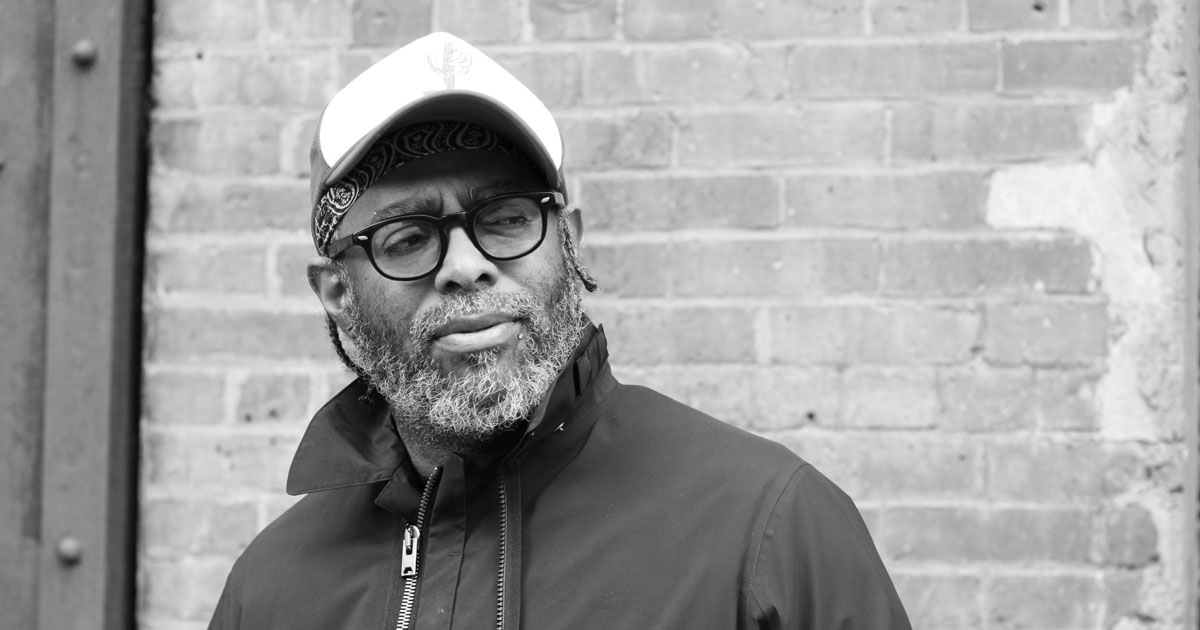[ad_1]
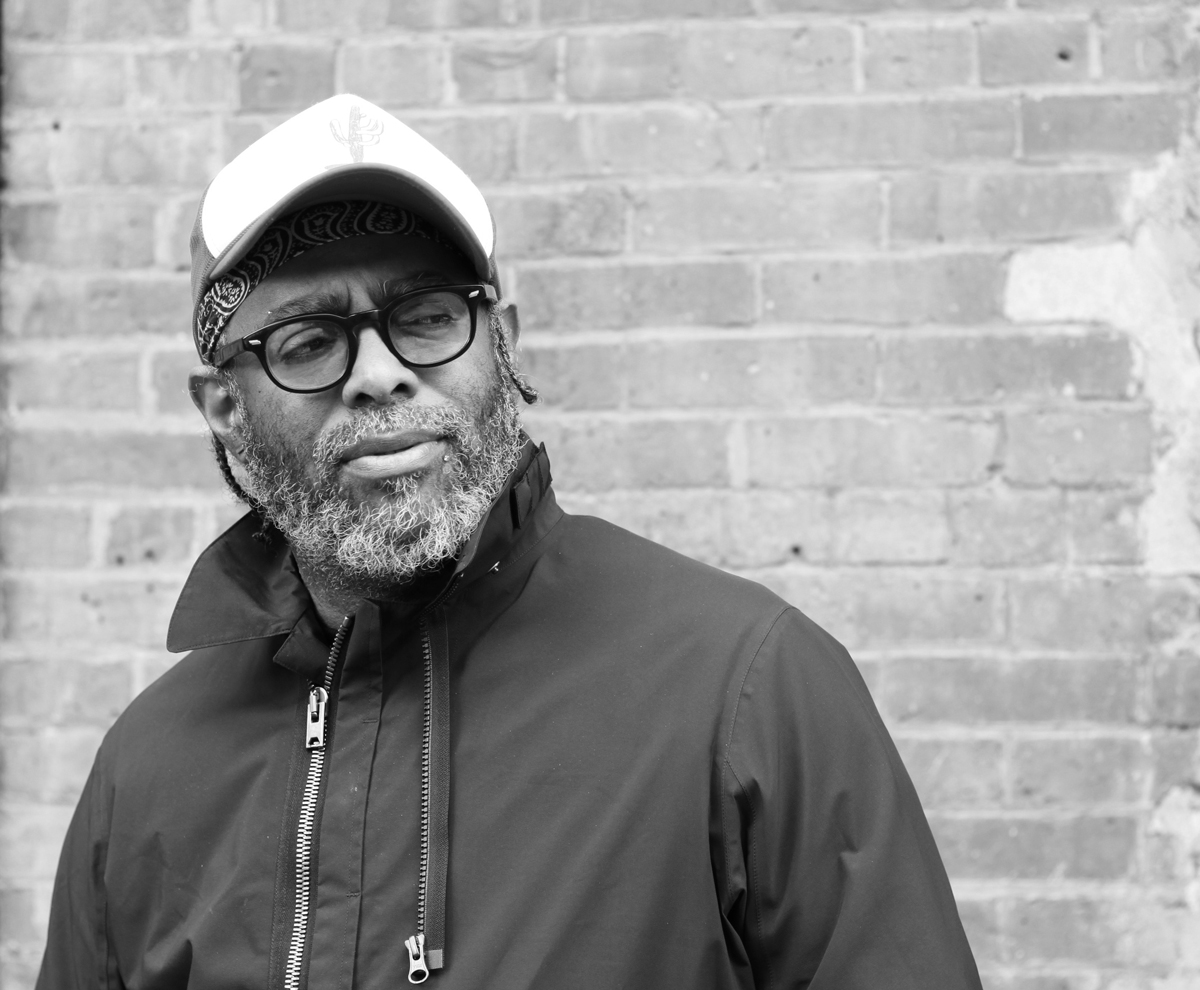
Arthur Jafa.
KATHERINE MCMAHON
[Read all five “Icons” profiles from ARTnews’s Spring 2018 issue, featuring Dara Birnbaum, Arthur Jafa, Amalia Mesa-Bains, Fred Moten, and Cady Noland.]
One evening last November, a year after the election of Donald Trump, guards at the Hirshhorn Museum and Sculpture Garden steps away from the White House were beckoning visitors to leave. It was closing time. As the guards turned a corner, sounds streamed from a gallery and light flickered from a projector; they swung open the doors to reveal a space packed with transfixed museumgoers.
“We on a ultralight beam, we on a ultralight beam, this is a god dream, this is a god dream, this is everything,” the lyrics swelled from inside the room.
Arthur Jafa’s seven-minute video Love Is the Message, The Message Is Death, screened on a loop, was starting over, and once again, Kanye West delivered the opening lines of a slowed-down version of his song “Ultralight Beam” as a dizzying array of found footage spliced together by Jafa flashed before the audience. No one budged, even after they’d already sat through the video in its entirety.
Just a year after its gallery debut at Gavin Brown’s Enterprise in New York, Love Is the Message has already been seen in museums across the world. Its opening sequence is bold: clips from within a Google rabbit hole sewn together into an unforgettable suite, the moving images enthralling and amusing and terrifying the viewer: A black man named Charles Ramsey talking about calling 911 when he found Amanda Berry, who had been kidnapped a decade earlier by bus driver Ariel Castro and kept in a basement while Castro and his brothers raped and tortured her; the crowd at a Howard University basketball game dancing to “Swag Surfin” by Fast Life Yungstaz; police officer Michael Slager shooting and killing the unarmed Walter Scott; Barack Obama singing “Amazing Grace” at the Emanuel African Methodist Episcopal Church in Charleston; the rapper Earl Sweatshirt spitting “the description doesn’t fit, if not a synonym of menace, then forget it”; Michael Jackson in a trucker cap dancing in the back seat of a town car; the sun with explosions like spores licking off its surface; an unarmed black woman in Texas getting pulled over after she left a Walmart and being handcuffed in front of her two kids when the police got word of a black person with a gun in the area; Cam Newton running toward the end zone; a Steph Curry behind-the-back pass; Miles Davis in giant sunglasses; a small black child being told, “That’s what the police do to you. Put your hands up against the wall.”
There in D.C., people stared wide-eyed, some quietly sobbing, as “Ultralight Beam” hit its stirring coda, to the sound of gospel singer Kirk Franklin offering a prayer and a thousand multitracked voices crying out “Faaaaaaaaaith!” LeBron James dunking dissolves into the blazing surface of the sun that in turn dissolves into James Brown grabbing a microphone stand and collapsing onto a stage.
Jafa’s Love Is the Message, The Message Is Death is the first breakthrough by an artist who has been perfecting his contribution to black visual culture for decades, but has only recently come into the spotlight. Before his solo show at Gavin Brown’s Enterprise in November 2016, the opening coming just days after the election, Jafa had not exhibited in a fine art context in nearly a decade; he had instead been working as a cinematographer, on other people’s projects.
Now, Arthur Jafa shows are traveling to institutions around the world, and his marquee work, created in edition, has been acquired by the Metropolitan Museum of Art, the Museum of Contemporary Art, Los Angeles, and the High Museum in Atlanta. Last fall, he was a new entry on the prestigious annual ArtReview magazine Power 100 list.
Although Love Is the Message came about quickly once the work started, it sprang forth from years of considering how to create a film in a lexicon that can intimate the African-American experience as well as popular music can—what Jafa has dubbed “black visual intonation.”
I interviewed Jafa in Gavin Brown’s personal office in his Harlem gallery on a sunny, bitterly cold December day. When asked about the film, Jafa said, “I suspected black people were gonna be moved by it, but I have to say, the most unexpected thing has been how strongly white folks, or nonblack people, have been moved by it.
“I mean, I don’t get to sit back and be the arbiter of whose response to it is legitimate or not, not at all, but it has been surprising.”

Arthur Jafa, Love Is the Message, The Message Is Death (4 stills), 2016.
©ARTHUR JAFA/COURTESY GAVIN BROWN’S ENTERPRISE
Jafa was born in Tupelo, Mississippi, in 1960, as Arthur Jafa Fielder—nearly everyone still calls him AJ. From childhood he had a desire to pair images together, and before age 10, he started a set of three-ring binders, what he calls “the books,” compiling images cut from magazines, pictures he liked, anything he thought needed to be next to something else.
“I used to cut things out, cut pictures out, you know, but I wasn’t doing, like, a proper book, I used to just put them in between the pages of books, like sketch pads, something like that,” he said.
We were still in Brown’s office, a neat little nook in his Harlem castle. Brown was not around, but he had given us free rein to check out the pad, and he had up some small Alex Katz watercolors near a window that looked out on the adjacent red-brick buildings.
“I would cut them out of the newspaper, thousands of them, probably,” Jafa went on. “It was all at that point pretty unconscious, but then at some point [it] started to be a way to consolidate ideas.” He went to Howard University, in Washington, D.C., and began to study architecture, understanding what he learned through his identity as a black man.
“I was very much interested in how to make a black painting, how to make black architecture. I definitely would have said something like, if x record was a house, if Kind of Blue was a house, what would it look like,” he said.
He moved to Atlanta after graduating, and got odd jobs in the city. He began to move away from architecture, and resolved to be an artist working in film, and to work with a vocabulary that would wear its black identity on the sleeve of its aesthetic form, not just in the content of its message.
“It was an epiphany,” he said. “I was sitting behind the apartment that we had in Atlanta, and I was looking at this tree that was sitting [in] this apartment complex, and it was a very peculiar sort of weather [condition] where it was sunny but there were clouds in the sky, and the clouds were moving, and I sat and watched this tree change color—the sky was exactly the same but the colors changed, it went from a bright greenish yellow to a dark brown, and it was just an epiphany: dynamic visual phenomenon, black visual intonation. . . . This [was] a full-blown epiphany, and to a certain degree, I’ve spent the last 30 years exploring the implications of that,” he added.
Jafa wanted to give black film the same agency that black music had developed through its cultural cachet: black visual intonation would be film’s way of communicating blackness in the same way that music did.
“With black visual intonation, it was really possible to create moving image phenomena parallel to [what you hear] in black music—and the music, that’s the one thing the people can agree on,” he said. “There was something about the unique status that the music had. In the context in which black people are, by and large, without favor, without sanctuary. But with music, it was the blackest thing out, but it seemed so much freer, and so much freer than any black person, as it could exist in contexts that otherwise black people wouldn’t be allowed into.”

Arthur Jafa, Love Is the Message, The Message Is Death (4 stills), 2016.
©ARTHUR JAFA/COURTESY GAVIN BROWN’S ENTERPRISE
In 1989 Jafa started working on independent filmmaker Julie Dash’s Daughters of the Dust. (Jafa would eventually marry Dash, who could not be reached for comment for this story, and they had a daughter during the film’s production.) The film’s story took place in the Gullah community, an African-American culture on the Sea Islands off the South Carolina–Georgia coast; Dash’s core team was Jafa and the African-American painter Kerry James Marshall, who served as art director. In this context, Jafa thought it was safe to have black visual intonation seep into the cinematography.
“You have these ideas, you’ve thought about them, you’ve talked about them, and you find yourself in an unprecedented position to implement, to pull the trigger on it,” Jafa said. “It was Julie’s film for sure, but me, Julie, and Kerry, we had a very complex, um, coauthorship of it on a certain level. Julie clearly directed it, I clearly shot it, Kerry did art direction on it, but there are these aspects of the mobilization of our personal energies.”
Daughters of the Dust bowed at Sundance in 1991 and lit up the festival, winning best cinematography for Jafa and ending up a finalist for the Grand Jury prize. Most important, it scored national distribution, making it the first feature film by a black female director to do so. First screenings at the New York theater Film Forum, at the start of 1992, sold out immediately.
“It was pre–social media, and so if it had [had] that effect with social media, it would have been explosive,” Jafa recalled. “We’re talking legit word of mouth—it was a thing, man. When it opened in New York you could not get tickets. Shit was sold out for weeks.”
It was acquired by the Museum of Modern Art, and Filmmaker magazine named it one of the 50 most important films of the 20th century, but the crush of fame affected the relationship between its two creators: Jafa separated from Dash during the film’s publicity period.
“Working with Julie was like being in Miles Davis’s band or something,” Jafa said, by way of a compliment.
He then added, “But like, you know, being married to Miles Davis . . . ?”
With the newfound recognition, he got hired to do B-camera work for Stanley Kubrick and Spike Lee, but craved the opportunity to work his theory on black cinema into his own film. “I was working for them, not with them,” he explained.
“I got really frustrated with that, and in the late ’90s, I was like, I think I’m gonna do the art thing,” he said. “It’s something I’ve always been obsessed with, and around ’98, I said, fuck this film thing, I’m gonna do this art thing, and I was pretty successful, pretty fast.”
The first artwork he made was placed in a show at the New York nonprofit gallery Artists Space in 1999 as part of a series called “Artists Select.” Jafa was selected by the renowned sculptor and painter Kiki Smith.
“Kiki had seen some of my video stuff,” Jafa shrugged. The only advice she gave me was, take up as much space as you can, and don’t start so narrow; just start as broadly as your interests are [broad].” The advice paid off. Shortly after that show, he was asked to participate in the 2000 Whitney Biennial.
“I was always very taken by the nuanced ways in which he wanted to explore questions around blackness,” said Valerie Cassel Oliver, one of the organizers of that year’s biennial. She went on to work with him on a number of shows, including “Double Consciousness: Black Conceptual Art Since 1970” at the Contemporary Arts Museum Houston and a show at Artpace in San Antonio, Texas.
“When we presented his work for the 2000 Whitney Biennial, we featured video shorts that almost appeared as still lifes, but they were very subtle, very poetic,” said Cassel Oliver, who is now curator of modern and contemporary art at the Virginia Museum of Fine Arts in Richmond.
Other shows followed, both here and abroad, as his standing among curators grew at a quick clip. Hans Ulrich Obrist, director of London’s Serpentine Gallery, told me he first met Jafa through a recommendation from curator Okwui Enwezor.
“I met him around the beginning of the millennium—Okwui said I should see his films, and I was incredibly excited about what I saw,” Obrist said. “Around 2000, he was doing things in the art world, and I invited him to a biennial in Seoul. He made an amazing film with the running movement of a dog going through the city.”
And then . . . radio silence.
“We somehow lost contact for 15 years,” Obrist said.
Indeed, after a few shows in 2005, Jafa decided to hang up his gloves and go back to working behind the camera. He’d given up the idea of being an artist, or at least he’d sidelined it.
It’s not unusual for fine artists to work on commercial projects. “Most artists, they have a commercial side that sustains them, but they’re constantly creating,” Cassel Oliver said. But Jafa had his own reasons for stepping back.
“I realized I wasn’t equipped to navigate the whole social and emotional terrain,” he told me.
“And it was much more segregated at the time. I just didn’t like it—I didn’t like interacting with collectors and stuff like that,” he went on. “Not only because I had some inherent, like, kinda natural aversion to collectors, but because there was just a racial divide. It was just a lot to navigate. I always felt like Jean-Michel could do the work, it was the social stuff that killed him.”
In addition to Jean-Michel Basquiat, Jafa went on to name a few other black artists who couldn’t handle the pressure, and ended up dying young, and then let out a sigh.
“It’s difficult for a person who’s not black to fully understand how demanding it all is—fuck the work, and the genius paintings, but how demanding and draining it is to operate as a black person in a fundamentally segregated context,” he said. “It’s not that people don’t love you and all this kinda stuff, it’s just fucking stressful, man.”
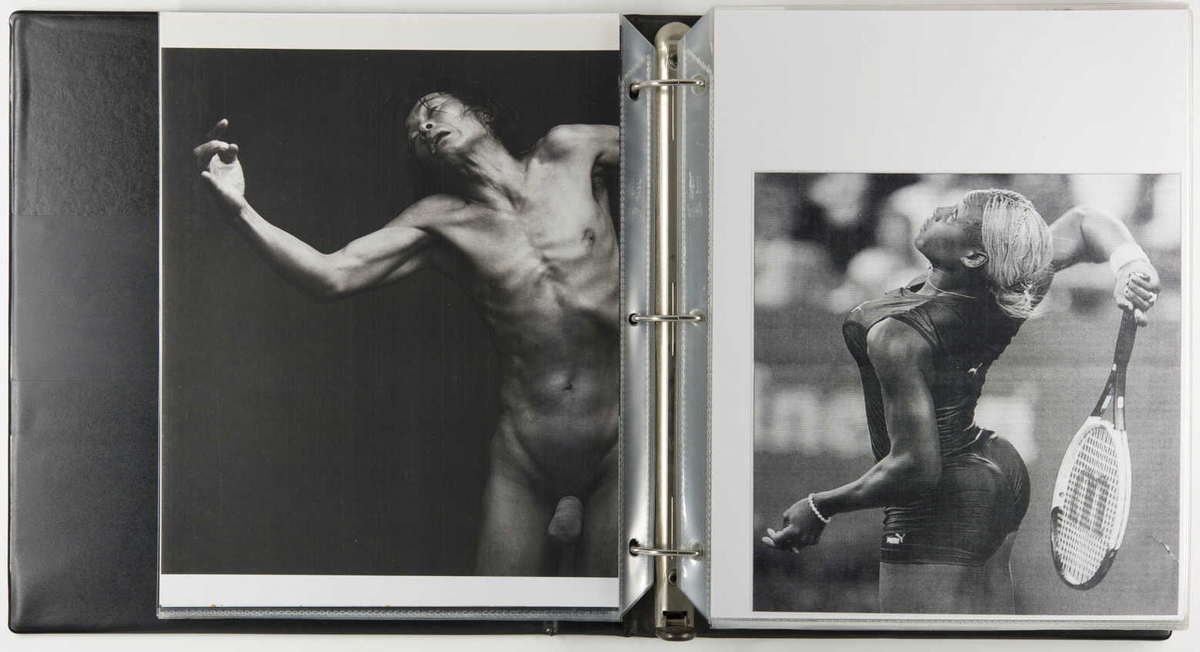
A detail of Arthur Jafa’s clipped imagery presented in binders at the Hammer Museum’s “Made in L.A.” exhibition in 2016.
©ARTHUR JAFA/COURTESY GAVIN BROWN’S ENTERPRISE
By the middle of the 2010s, Jafa had settled comfortably into his career making documentaries and taking gigs as a cinematographer on other projects, and in 2014, he teamed with curator Elissa Blount-Moorhead and filmmaker Malik Sayeed to form the Los Angeles–based TNEG, a production company that supports black independent film. That same year, he made a short “docu-poem” with filmmaker Kahlil Joseph, Dreams Are Colder Than Death, that got some love from the festival circuit but little else.
But it turned out the art world was paying attention. When the Hammer Museum in Los Angeles released the list of artists in its 2016 Made in L.A. biennial, among them was “cinematographer Arthur Jafa.”
Made in L.A. curators Hamza Walker and Aram Moshayedi had to plead with Jafa to participate. “It was very difficult for them to convince him to come back to the world of exhibitions,” Obrist explained. When at last he relented, Jafa decided to restart his career as an artist where it had begun: with “the books,” his binders of juxtaposed found images. At the Hammer, rows of them stretched across the center of a gallery, and visitors could flip through them at their leisure.
“It was very inspiring—I could not leave these vitrines, connecting all these images, and looking at his incredible way of editing,” Obrist said of the presentation.
Compiling the binders inspired Jafa to think about how a montage of disparate clips of moving images could be a black art form. And there was powerful raw material: on YouTube, camera phone footage of violence against black people was being publicly disseminated.
“Modern technology is giving us a front-seat view of the unprovoked violence upon black bodies; when you see that, there is no justification for it,” said Cassel Oliver. “There’s a whole generation that’s grown up with this outrage.”
Jafa began to throw such videos into a folder on his computer desktop, along with clips of prominent black activists and athletes, rappers in videos, and people dancing. And he started to find a rhythm in them, a balletic structure where one discrete clip of movement could blend into the next.
He just wasn’t sure what to do with it.
“It was just one of several files that I was always compiling,” he said, starting to talk about the origin of Love Is the Message, The Message Is Death. “Everyone’s struck by this stream of videos of black people being murdered, so I started throwing them in the file, and I strung them together, and put it together very quickly, two or three hours.”
This was February 2016, when Kanye West was letting songs from his new album, The Life of Pablo, dribble out. Just after midnight on Valentine’s Day, West performed “Ultralight Beam” on Saturday Night Live.
“I was futzing with [the clips] for a few days and I saw Kanye on SNL,” Jafa said. “I said, wow, that’s an interesting song, so a couple of days later I got the music, and I laid it down. I didn’t have a deadline or anything, so I was tweaking it and showing it to people.”
One of those people was Kahlil Joseph, who was so taken with it that he started playing it before screenings at the Underground Museum, an institution founded by Joseph’s late brother, the artist Noah Davis, in the Arlington Heights neighborhood of Central Los Angeles. Before each film, there would be one showing of Love Is the Message sans any kind of introduction. In the small community around the Underground Museum, it started to achieve a sort of legendary status.
“I didn’t know he was doing that, because I didn’t attend those screenings, but when I would show up at the Underground Museum, everyone was saying like, ‘Much respect!’ and I was like, what are you talking about?” Jafa said.
Joseph started showing it to whomever he could persuade to watch. In June 2016, the Athens gallery Bernier/Eliades brought Joseph’s film m.A.A.d. to the Art Basel fair in Basel, Switzerland, complete with its own screening room in the fair’s Unlimited sector. While there, Joseph set up an invite-only screening of the original, never-before-seen cut of his film Lemonade, commissioned for the Beyoncé album of the same name. The pop star had originally asked Joseph to helm the whole project, but when it came out too dark, she went in another direction (including drawing heavily from Daughters of the Dust for inspiration).
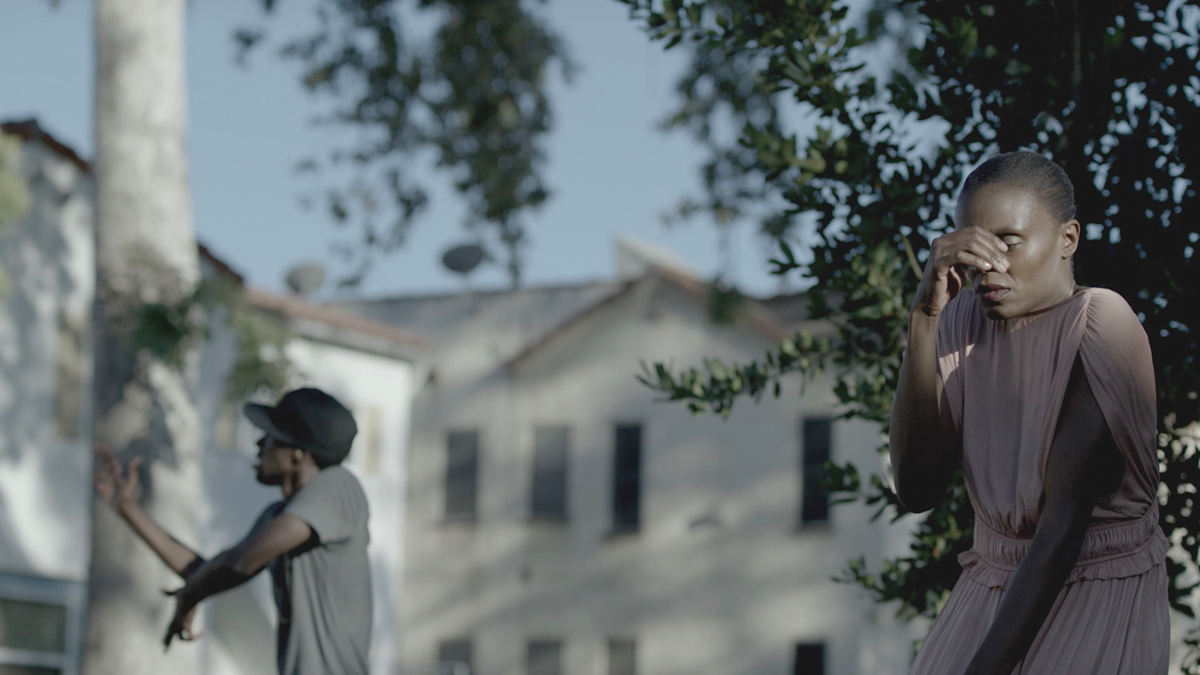
A still from JAY-Z’s 4:44 music video, directed by Arthur Jafa.
©ARTHUR JAFA/COURTESY GAVIN BROWN’S ENTERPRISE
One of the people who came to see Lemonade in Basel was Gavin Brown, who left an Artforum dinner early to make the screening. When the lights went down, however, instead of a Kahlil Joseph film, Love Is the Message, The Message Is Death lit up the screen, Joseph showing it as a preview just as he had at the Underground Museum.
“There had been no introduction, no explanation . . . completely without warning Love Is the Message just came on,” Brown told me over the phone. “It was a physical experience—when you have no idea what you’re looking at, it becomes an experience to which you cannot apply any preconceptions. It was one of [the] most pure art experiences I’ve ever had, because I had no idea what I was looking at.”
After the screening, Brown asked Joseph about the first film, “and he said, ‘By my friend,’ and he said this name, and I had never heard this name before,” Brown explained. The following morning Brown called one of the artists in his stable whom he thought had to know about the video he’d seen.
“I called Mark Leckey at 7:00 am and woke him up, and I said, ‘I’ve just seen . . . something,’ ” Brown said. “I guess I was trying to tell him [I’d seen] something that we’ve both been waiting for for a long time.”
Brown started digging around for information on Jafa. “All I could find out was that he was a cinematographer—but whoever made this object, it seemed to function in my world as art,” he said.
Brown got a contact for Jafa through Walker and Moshayedi, the Made in L.A. curators, and called him, cold.
“When Gavin called me, I was driving my son to school,” Jafa said. “He said, ‘I saw Love Is the Message, and I want to talk to you.’ ”
“He was still a mystery to me, but I was not a mystery to him, which was an unusual situation for me,” Brown said. “He said, ‘Hold up, stop talking, I know who you are, I’m coming to New York, let’s get together.’ ”
Lunch in Harlem led to a four-hour conversation, during which Brown offered Jafa a show at his gallery.
“It was one of the more incredible encounters in my life, really,” Brown said.
“He called me the next morning and said, let’s do it,” Jafa said. “And I said, do what? He said, ‘First off, let’s show Love Is the Message.’ I said, ‘You wanna show it next year or something?’ And he said, ‘No, two weeks. Let’s show it for the election.’ ”
“I was hoping that we could do something rapidly, spontaneously and with verve,” Brown said. “And no, we had never done anything like that before. I didn’t really talk to other people at the gallery about it.”
They made plans to open the show November 12, a Saturday, and in the early morning of November 9, Donald Trump was elected president.
“In my mind, most people after the election were waking up and going to work, and the Saturday morning was the first people had a moment to reflect on what had happened,” Brown said.
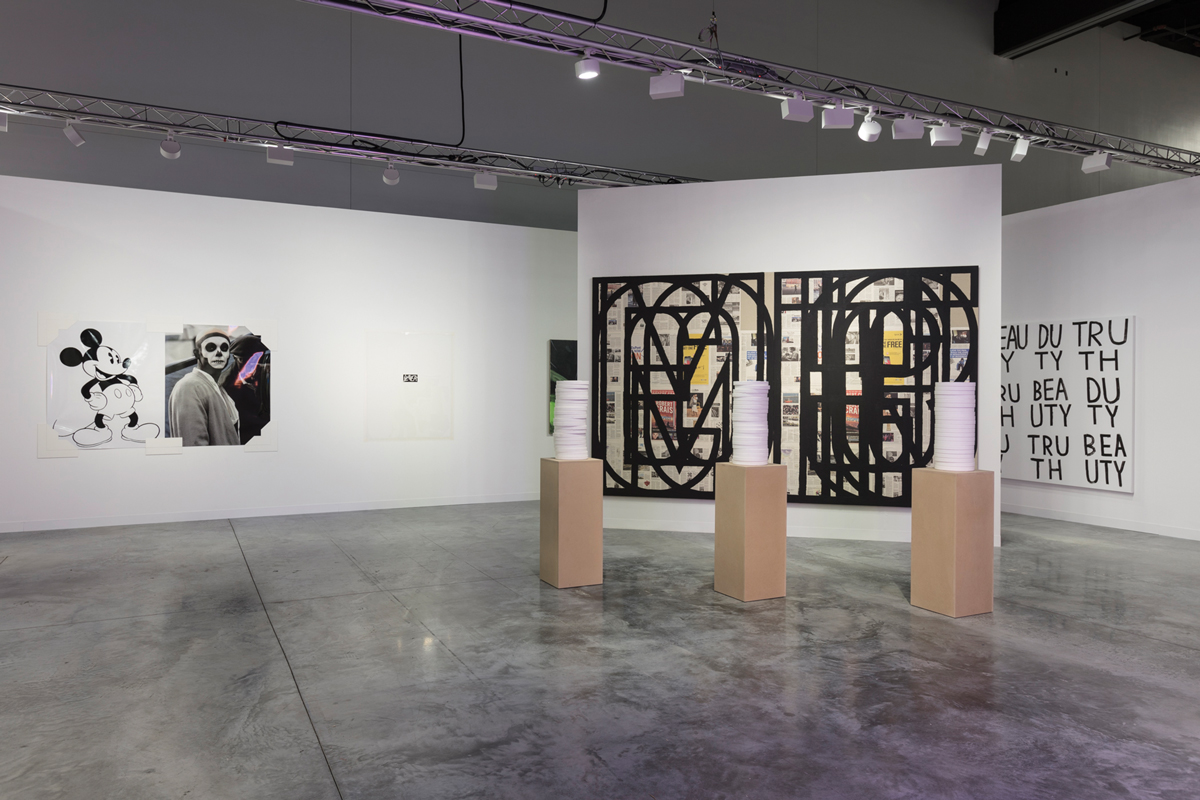
The Gavin Brown Enterprise booth at Art Basel Miami Beach in 2017, with Arthur Jafa’s Mickey Mouse Was a Scorpio (2016) displayed at left.
It was a true phenomenon, not unlike the release of Daughters of the Dust, but this time with social media. The nature of the short clips made it easily snapped for Instagram, but those stories stressed that Love Is the Message had to be seen in full and in person. Lines began to form as hundreds, and then thousands, trekked up to Harlem to see the work that seemed to provide some catharsis for a city broken by the election, unable to figure out how we got there.
“They encountered a film that seemed to describe this country back to itself, and describe the underlying conditions of racism that produced that election, that produce the conditions that prejudiced people who could vote for that man,” Brown told me. “It was just extraordinary timing.”
A headline in the New Yorker called it “required viewing.” New York Times critic Roberta Smith, in her column listing the best art she had seen in 2016, called it “a seven-minute-long life-changer.”
“Friends of mine, they’d told me, ‘You have to see this,’ ” said curator Mark Beasley, who acquired it for the Hirshhorn and placed it in “The Message,” an exhibition of new film works that took its name from Jafa’s piece. “It was the last time that I was moved in a gallery in a way that I had to ask myself, what is happening to me? Sometimes the timing’s right, and right now, the time requires this kind of work, this kind of message, because it speaks to now.”
Obrist, who happened to be in New York the week of the election, was one of the few who knew Jafa’s work going into the show, and thus had some sense of what he was about to see. Still, he said, it shocked and surprised him.
“The opening at Gavin Brown was very, very important; it gained a bigger urgency—his work has always had an urgency, going back to the 2000s,” Obrist said. “And that urgency of course was much, much stronger after the election.”
Obrist gave Jafa a solo show at the Serpentine Gallery in London, in June 2017; it traveled to the Julia Stoschek Collection, a private museum in Berlin. Love Is the Message also traveled to MOCA Los Angeles. It was recently on view at the Van Every/Smith Galleries at Davidson College in North Carolina, and in the summer, will be shown at the Institute of Contemporary Art, Boston. The Metropolitan Museum of Art in New York and the High Museum in Atlanta both acquired it. In the meantime, JAY-Z tapped Jafa to direct the video for the title track off his new album, 4:44.
“Quite simply, the world caught up with AJ—he’s always been where he’s been,” Cassel Oliver said.
In May, Jafa will show new work at Brown’s gallery. Both artist and dealer stayed mum on what will be included, but told me there will be a new video.
Back in Brown’s office, Jafa toyed with a braid in his hair, and leaned back on the couch as he tried to envision what was to come. “Next is a tsunami of stuff,” he said, sounding hesitant but excited. “It’s the product of having been in suspended animation for 20-something years. It was all on hold for so long, and now I got a lot in the works.”
A version of this story originally appeared in the Spring 2018 issue of ARTnews on page 56 under the title “The Messenger.”
[ad_2]
Source link

